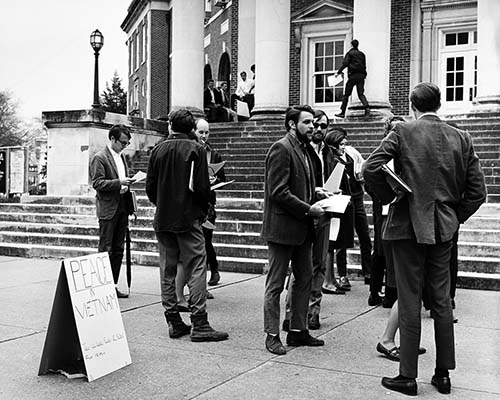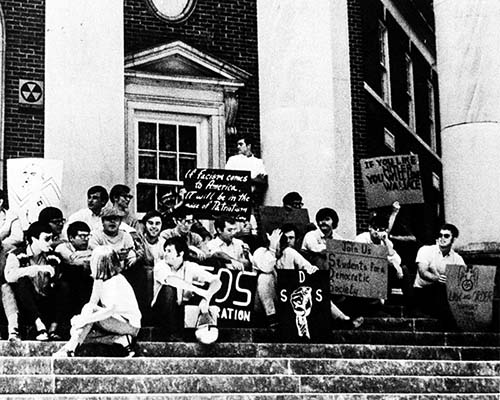You say you want a revolution
“Revolution 1,” The Beatles
Well, you know
We all want to change the world
To understand what happened at Kent State and the weeks after, including the tragedy at Jackson State, you have to understand the historical moment.
Late 1960s America
The late 1960s in the U.S. was marked by an upheaval in cultural norms, with traditional structures coming under attack from the disenfranchised and from those who simply sought another way.
Among dozens of iconic moments of counterculture, these key protest events from 1968 and 1969 illustrate the range of causes championed in the period — and why people, especially African Americans, had begun to fear armed intervention.
Orangeburg massacre
(Feb. 1968)
Highway Patrol officers kill 3 Black students from S.C. State University who had been protesting segregation at a local bowling alley
King assassination riots
(Apr. 1968)
After the killing of Rev. Martin Luther King Jr., riots rock cities across the country, especially Baltimore, Chicago, and Washington D.C.
Chicago Democratic National Convention protests
(Aug. 1968)
City police use harsh riot control measures on anti-Vietnam War protests led by the Yippies and the Mobe
Miss America protest
(Sep. 1968)
An early Women’s Liberation demonstration at the pageant’s home in Atlantic City saw protesters burn women’s products in a Freedom Trash Can
Bloody Thursday at People’s Park
(May 1969)
Highway Patrol & city police attack U.C. Berkeley demonstrators attempting to re-take an empty lot being used as a free speech area
Greensboro uprising
(May 1969)
City police & National Guard violently clash with protesters from N.C. A&T State University and a nearby high school over fears of Black Power activism
Stonewall riots
(Jun. 1969)
A foundational moment in LGBTQ history, patrons of a Greenwich Village gay bar defend it against NYC police after a raid
Occupation of Alcatraz
(Nov. 1969)
Native American activists begin a long occupation of the former prison island off the coast of California in order to reclaim it from the federal government
Protest Culture at the University of Alabama

While most accounts of the late 1960s and early 1970s at UA make clear that the activist students were a minority, they were a very vocal one. And they often spoke of concerns that many of their classmates shared.
Articles covering all of these incidents and more are found at the bottom of the page under Primary Sources.
1968
- Mar. 15 & 22: Democratic Student Organization (DSO) peace vigils — Related to the Vietnam conflict. DSO was a local organization that took the lead in campus protests before the UA chapter of Students for a Democratic Society (SDS) was given a charter.

- Oct. 21: Speaker ban march — Students protested the refusal of administration to permit four radical figures to speak on campus:
- Herbert Aptheker, a Marxist historian;
- Eldridge Cleaver, a leader in the Black Panther Party;
- Tom Hayden, a leader in Students for a Democratic Society; and
- Jerry Rubin, a leader in the Youth International Party (Yippies).
- Oct. 31: DSO police harassment protest
1969
- Oct. 15: Moratorium to End the War in Vietnam — This was part of a nationwide demonstration.

- Nov. 6: AAA march and sit-in – The Afro-American Association presented a list of demands to the administration:
- implementation of a Black Studies department,
- formation of an orientation program for Black freshmen,
- construction of an Afro-American center,
- better benefits for Black workers on campus,
- hiring of Black professors,
- desegregation of Greek organizations, and
- actions to end racism and discrimination in the athletic department.
- Nov. 10: ROTC protest
Spring 1970
- Mar. 5-6: Speaker ban sit-in and march — Students protested the refusal to let another radical figure speak at the University: Abbie Hoffman, a leader in the Yippies.
- Apr. 13-15: Vietnam peace fast
- Apr. 23: Protest at President’s Day — This small demonstration of the campus military organization resulted in two students being bodily carried off the ROTC field by campus police.

Sources
“Revolution 1,” performed by the Beatles and written by John Lennon, was released as a single, August 1968, the B-side to “Hey Jude,” then in November on The Beatles [the White Album]
Secondary
- Earl H. Tilford, “Campus Militancy Grows,” Turning the Tide: The University of Alabama in the 1960s, Tuscaloosa: The University of Alabama Press, 2014, pgs 149-168.
- Earl H. Tilford, “In Defense of Reason,” Turning the Tide: The University of Alabama in the 1960s, Tuscaloosa: The University of Alabama Press, 2014, pgs 169-189.
Primary
- Bailey Thomson, “Progressive Party Organizes at UA,” Crimson-White, Dec. 14, 1967, pg. 2.
- Pete Cobun, “Friday Peace Vigil Is ‘Just First of Many’,” Crimson-White, Mar. 18, 1968, pg 1.
- “Peace: ‘Is a Better Way’,” Crimson-White, Mar. 21, 1968, pg 1.
- “Silent Peace Vigil Again; This Time in Noon Downpour,” Crimson-White, Mar. 25, 1968, pg 1.
- Bailey Thomson, “Rose Refuses to Admit Radical Four; DSO Will File Suit to Bar Speaker Ban,” Crimson-White, Oct. 15, 1968, pg. 1.
- “What Price, Academic Freedom?” [editorial], Crimson-White, Oct. 15, 1968, pg. 4.
- Pete Cobun, “Baines, Reporter Arrests Climax DSO March,” Crimson-White, Oct. 24, 1968, pg 1.
- Pete Cobun, “Last DSO Protest Stirs 100 To Steps,” Crimson-White, Nov. 5, 1968, pg 1.
- “Speaker Ban Testimony Is Heard,” Apr. 16, 1969, pg 1.
- Bill Kilgore, “SGA Back Campus Vietnam Moratorium,” Crimson-White, Sep. 29, 1969, pg 1.
- Bill Kilgore, “Senate Delays Passage Of Moratorium Resolution,” Crimson-White, Oct. 2, 1969, pg 1.
- Donna Bible, “Coalition Groups, SGA Want Educational Format for Vietname Moratorium,” Crimson-White, Oct. 2, 1969, pg 1.
- Charlotte Higgins, “Viet Bill Passes,” Crimson-White, Oct. 9, 1969, pg 1.
- Rick Fitch, “Moratorium Will Be Largest,” Crimson-White, Oct. 16, 1969, pg 1.
- Ann A. Fambrough and Oakley Garnett, “More on Moratorium from UA Students,” Crimson-White, Oct. 16, 1969, pg 1.
- “Moratorium Day University of Alabama Schedule of Events,” Crimson-White, Oct. 13, 1969, pg 1.
- Donna Bible, “Bircher, Afros Air War Views,” Crimson-White, Oct. 16, 1969, pg 1.
- “Vandals Mutilate Moratorium Signs,” Crimson-White, Oct. 16, 1969, pg 1.
- “7-Point Sit-Down Staged,” Crimson-White, Oct. 27, 1969, pg 1.
- Donna Bible, “Afros Present List of Demands,” Crimson-White, Nov. 10, 1969, pg 1.
- Rick Williams, “Protesters Interrupt ROTC,” Crimson-White, Nov. 10, 1969, pg 1.
- Ed Still, “Decision on Ban Due Saturday,” Crimson-White, Mar. 9, 1970, pg 1.
- Bill Kilgore, “Public Opinion Affected Decision,” Crimson-White, Mar. 9, 1970, pg 1.
- Donna Bible, “Hoffman Tape Gets the Ban,” Crimson-White, Mar. 17, 1970, pg 1.
- Donna Bible, “Peace Fast Begins Today: 3 Days of Events Planned,” Crimson-White, Apr. 13, 1970, pg 1.
- “UA Police to Probe Arrest; 2 Carried From ROTC Field,” Crimson-White, Apr. 27, 1970, pg 2.
- “Questionable Force,” Crimson-White, Apr. 27, 1970, pg 4.